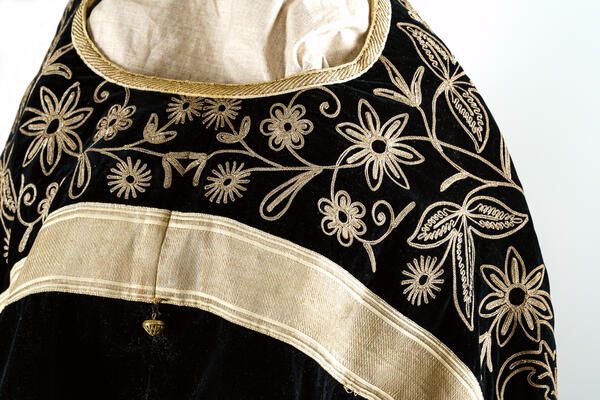Every detail of the vestments and clothing that priests and church ministers wear during services has its own name and symbolic meaning. Even the color is strictly defined by tradition.
The phelonion is a type of upper sacred garment used during worship services. One of the symbolic meanings of the phelonion is the Tomb of the Lord. It also represents the royal robe of the Savior and the armor of a warrior. In the Orthodox Church, the phelonion is a liturgical vestment worn only by priests, as archbishops wear a sakkos during the liturgy.
Originally, the phelonion was a loose garment made of soft fabric with a single opening for the head. Over time, it was shortened for ease of movement and adorned with embroidery. Nowadays, the phelonion is long in the back, while the front has a rounded neckline, reaching only to the waist.
In ancient times, phelonions were long — down to the feet, both in the back and front. Essentially, it was a pallium — an ancient cloak of “sun” design. It even covered the priest’s hands, symbolically indicating that the priest performs the sacraments not by his own power, but by God’s power, as well as renouncing worldly temptations and greed.
In different national traditions, the phelonion looks different. The Russian phelonion has a stiff standing trapezoidal collar, while the Greek one lies freely on the shoulders. It is presumed that the standing collar of the Russian phelonion appeared due to the cold winters, as it provides good protection against drafts.
The four horizontal stripes on the phelonion symbolize the four Gospels. At the top of the phelonion on the back is a cross, and at the bottom is an eight-pointed star, which is sometimes referred to as a custodia. This indicates the unity of the Old and New Testaments.
The color of the vestments in the Russian liturgical tradition depends on which day of the liturgical year the Church is observing. The black color of the vestments symbolizes the time of Holy Week, when the Church prayerfully stands before the Cross of Christ, remembering how heaven and earth were horrified at the sight of the suffering Creator. The vestments become black to symbolize mourning.
The epitrachelion is an
element of the liturgical vestments of priests and archbishops — a long ribbon
that wraps around the neck and descends to the chest with both ends, either
sewn together or fastened with buttons in the front. It is worn over the sticharion
or cassock. It symbolizes the gracious gifts of the priest as a minister. The
archbishop wears the epitrachelion as a sign of preserving the priestly
gracious gifts. Without the epitrachelion, neither the priest nor the
archbishop can administer sacraments.





